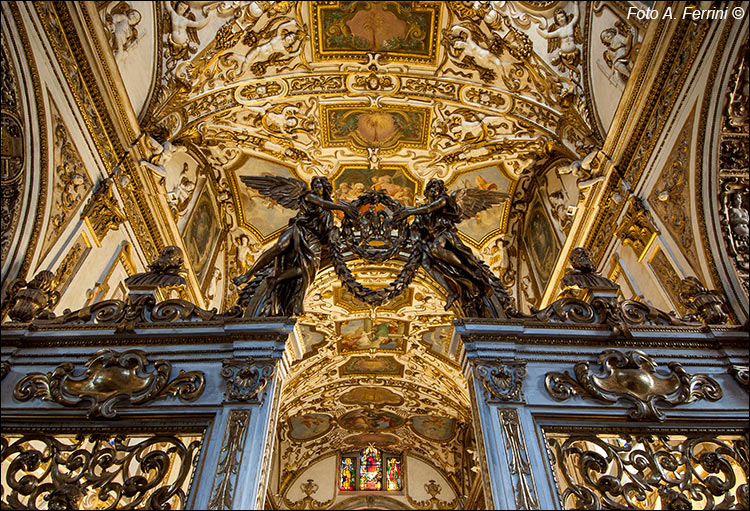Camminando tra storia, leggende, fede e natura
un itinerario tra Monastero ed Eremo di Camaldoli nel Parco Nazionale
Italiano
ITINERARIO CAMALDOLI GIOGANA COTOZZO 19
L’interno della chiesa dell’Eremo di Camaldoli, dedicata alla Trasfigurazione di Gesù, si presenta in stile barocco. È la terza chiesa di questo sacro luogo, fu costruita a cavallo tra XVII e XVIII secolo dopo che un incendio aveva distrutto la precedente. La prima chiesa fu in realtà un oratorio costruito da San Romualdo e i suoi cinque discepoli consacrato nel 1027 dal Vescovo di Arezzo Teodaldo. Per il numero dei monaci in crescente crescita, il sacro edificio si rivelò ben presto piccolo, così alla fine del secondo decennio del XIII secolo si costruì una ben più grande chiesa in stile romanico consacrata nel 1220 dal Cardinale Ugolino, futuro Papa Gregorio IX. È la chiesa che andò distrutta da un incendio nella seconda metà del XVII secolo. Lo stile fortemente barocco dell’attuale chiesa, con tanto legno e stucchi dorati, contrasta molto con il sobrio ambiente del Sacro Eremo. Il soffitto e le pareti sono decorate con dipinti di fine Seicento, prima metà del Settecento. Le due opere più note qui conservate sono, però, una robbiana di fine Quattrocento e un dipinto del 1563, un’eredità della chiesa precedente. Si tratta di una terracotta di Andrea della Robbia che vedremo nella pagina successiva e la pala dell’altare maggiore, una tavola di Agnolo di Cosimo di Mariano, detto il Bronzino, dove è raffigurata la Crocefissione di Gesù tra i Santi Romualdo, Pietro, Paolo e Francesco. La facciata della chiesa, con i due campanili gemelli considerati il simbolo di questo luogo, fu costruita all’inizio del XVIII secolo. The interior of the church of the Hermitage of Camaldoli, dedicated to the Transfiguration of Jesus, is in Baroque style. It is the third church of this sacred place, it was built between the 17th and 18th centuries after a fire had destroyed the previous one. The first church was actually an oratory built by San Romualdo and his five disciples consecrated in 1027 by the Bishop of Arezzo Teodaldo. Due to the growing number of monks, the sacred building soon proved to be small, so at the end of the second decade of the thirteenth century a much larger Romanesque-style church was built and consecrated in 1220 by Cardinal Ugolino, the future Pope Gregory IX. It is the church that was destroyed by fire in the second half of the 17th century. The strongly Baroque style of the current church, with lots of wood and gilded stucco, contrasts greatly with the sober environment of the Sacred Hermitage. The ceiling and walls are decorated with paintings from the late seventeenth and first half of the eighteenth century. The two best-known works conserved here are, however, a Della Robbia from the late fifteenth century and a painting from 1563, a legacy from the previous church. It is a terracotta by Andrea della Robbia that we will see on the next page and the altarpiece of the main altar, a table by Agnolo di Cosimo di Mariano, known as Bronzino, where the Crucifixion of Jesus is depicted among the Saints Romualdo, Pietro, Paolo and Francis. The facade of the church, with the twin bell towers considered the symbol of this place, was built at the beginning of the 18th century.








































































